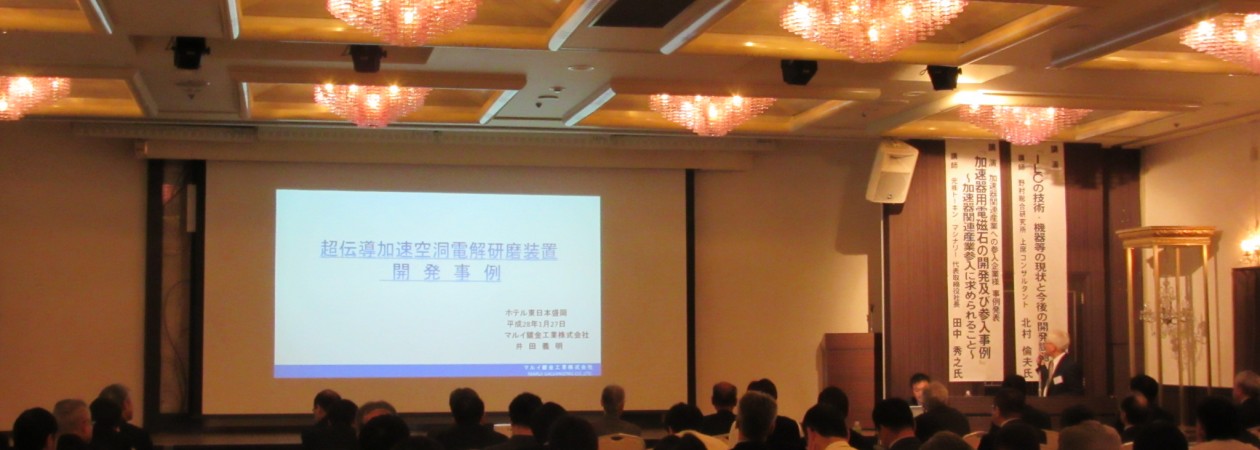The ILC will not only be a chance to research at the forefront of fundamental physics, but also a great opportunity for local Tohoku and Iwate businesses. Much potential lies in getting involved with the R&D and manufacturing of accelerator parts and other related machinery. However, while plenty of manufacturing companies exist locally (we have a booming semiconductor industry in Iwate!), it will be a challenge to produce these next-generation parts and train their staff to work in an international environment. That’s where the Iwate Accelerator-related Industry Lecture Series comes in. These lectures are periodically held to encourage and support local businesses in getting involved with accelerator-based industry.
At the tail-end of January, they held another seminar on this subject and a chance to network with representatives of local academia, government, and industry.
Michio Kitamura of Nomura Research Institute (NRI) spoke about the technology for the ILC as well as future challenges for development. Kitamura is a member of a research and analysis committee commissioned by Japan’s Ministry of Education, Culture, Sports, Science and Technology (MEXT) to study the technical feasibility and economic effects of the ILC project. He spoke about the challenges in scaling up two key technologies required for the ILC:
Superconducting radio frequency (SCRF)
This technology is used to accelerate the particle beam (of electrons and positrons) within a superconducting cavity. Wait- what? Fermilab, a national laboratory in the United States specializing in high-energy particle physics, has this explanation:
“The ILC will accelerate electrons and their opposites, positrons, close to the speed of light. In order to provide the necessary acceleration to make particles collide at 500 billion electron volts, the ILC will use superconducting radiofrequency cavities made of pure niobium that are chilled to 1.8 degrees above absolute zero. As many as 16,000 cavities, each roughly a meter long, and placed end-to-end in vessels called cryomodules, will drive the electrons and positrons forward with an accelerating gradient of more than 30 million volts per meter (MV/m). The higher the gradient, the shorter, and hence cheaper, the ILC can be made.”
Read more at Fermilab’s R&D page for SCRF technology
It was decided in 2004 that the ILC would use these superconducting cavities in its design, and Japan (KEK), Germany (DESY), and the United States (Fermilab, SLAC) have been at the forefront in developing this technology. They have succeeded in reaching the target values (a maximum accelerating gradient at 31.5 MV/m) needed for the ILC in about 90% of cavities, with the next steps being to improve the practicality and reliability of the device.
Nano-beam handling
Electrons and positrons are both elementary particles, the smallest bits of matter possible. Colliding these two together requires a high level of precision, and the ILC will need to squeeze its particle beams down to the nanometer level, using electromagnets and technology that allows for stability and precise control. These beams also need to be ultralow-emittance beams, which means that all of the particles in the beam are confined mostly together – there’s very few particles wandering off somewhere else. The beams will be made up of particles all the same charge after all (electrons being negative, and positrons being positive), and particles of the same charge naturally repel each other. The beam technology in the ILC will need to prevent that from happening as much as possible to ensure a nice collision.
The Accelerator Test Facility (ATF) at Japan’s High Energy Accelerator Research Organization (KEK) has been globally-unique in developing this technology. ATF is working towards a goal beam size of 37 nanometers. When produced at the energies required for the ILC, this beam would become even smaller – a teeny tiny 5.9 nanometers!
In essence, the ILC will be using technology that already exists in some form or will most likely exist by the time it is constructed. After surveying a number of major research facilities in the U.S. and Europe, the NRI committee has determined that it is unlikely that the preparations and construction for the ILC will require some altogether new form of technology. However, R&D must progress towards improving the level of already-existing technology with mass production and lowered costs. It may be possible to make one working prototype, but how about 16,000 of them? With a project at this scale of global participation, what country will be responsible for which parts? Managing global logistics and supply chain issues, and training staff with the experience and technical knowledge in these areas will be necessary.
Roughly 1,850 cryomodules (vessels that cool the SCRF cavities) need to be manufactured for the ILC accelerator, as well as sensors, other electronics, wiring, and more. Someone needs to make those parts, and factories could be sited right in this area. If companies in the local area are up to the task, the ILC facility could order parts from their backyard. The entire region could become an incubator for ILC technology, development, and related services (kind of like our own Silicon Valley).
Healthcare, motor vehicles, nuclear waste handling, semiconductors, electron microscopes, energy development, ion batteries – you name it, accelerator-based research is involved in creating and developing these technologies. What about using innovations for the ILC in Iwate’s famed agriculture industry? You could use ion beams to breed hardier rice, or develop new mutations in Nanbu-Ichiro squashes (a local delicacy) to deal with the cold weather. The possibilities are endless.
Two case studies were presented on getting involved with accelerator industry. Hideyuki Tanaka of Tokin Machinery talked about their forays into electromagnetics (their magnets are used by the high-speed bullet train in Taiwan!). Yoshiaki Ida of Marui Galvanizing talked about his company’s electropolishing processes, which could be used on the cryomodules/superconducting cavities to erase imperfections (a micron off and you could throw the whole particle beam off). Both speakers were clear that getting involved with this industry will require preparation and planning, as you are getting involved with experimental research and new frontiers. You need new ideas to stand outside of the pack. Further work must be done to match the region’s skills and technology with the needs of the researchers.
Masanori Matsuoka and Hiroyuki Yoshizumi of AAA (The Advanced Accelerator Association Promoting Science & Technology) said it best at the end. If you want your company to be involved in this exciting field, remember your client’s needs:
1) To collide particles at high speeds
2) in a very small beam, and
3) and to accurately record and analyze that data
Anything that can help the ILC realize its goals is welcomed.
Nobody could have predicted how the birth of the World Wide Web at CERN to share information between researchers would become so intrinsic to modern life. Innovation is not something you can predict beforehand, but what is certain is that accelerators can help join the world together as we search for things we have never seen before. Dr. Masakazu Yoshioka, emeritus professor at KEK and guest professor at Iwate University and Tohoku University, had a few last words. Accelerator-based research is the frontier of mankind’s understanding of the universe. Within this unique field lies great technological advances and greater challenges still. The ILC project, as well as other accelerator-based projects in Aomori and Fukushima shows that Tohoku is ready to try its hand at accelerator-type projects, and there is so much possibility for international collaboration in all fields. A new frontier, born in Tohoku!
If the ILC is realized, this would be the first time for Japan to host such a project of this size. Thousands of people will come to live in the area, and they will give so much to Tohoku. Our final goal should be to use the leaps made at the ILC and contribute it back to the world.
Further details about NRI’s analysis of the technical and economic effects of the ILC can be found on MEXT’s website in Japanese.
Japanese
加速器関連産業の参入へ向けていわて加速器関連産業研究会の第2回「加速器関連産業参入セミナー」
和山アマンダ
ILCは、基礎物理学の研究フロンティアであるだけでなく、東北と岩手の地元企業にとって大きなチャンスです。加速器部品や関連機器の研究開発、製造などの可能性があります。しかし、岩手では半導体などのモノづくりは盛んであるものの、次世代部品の製造やグローバルな環境で働く人材の育成が課題です。そこで、加速器関連産業の参入を支援・促進するため、「いわて加速器関連産業研究会」が設立されました。
同研究会が1月下旬に、加速器関連産業に関わる産学官の交流・連携機会の創出等を行う「第2回加速器関連産業参入セミナー」を開催しました。
「ILCの技術・機器等の現状と今後の開発課題」について、野村総合研究所の上席コンサルタント北村倫夫氏が講演をしました。野村総合研究所は、文部科学省に委託され、ILC計画に関する技術的な実現可能性や経済的波及効果等について調査分析をしています。北村氏は、ILCで要求される2つの鍵となる技術の動向や課題について話しました。
(これより、野村総合研究所の『国際リニアコライダー(ILC)計画に関する技術的・経済的波及効果及び世界各国における素粒子・原子核物理学分野における技術面を含む研究動向に関する調査分析』を一部抜粋しました)
超伝導高周波加速技術 Superconducting radio frequency (SCRF)
超伝導高周波加速器空洞を使って粒子ビーム(電子と陽電子)を加速する技術。えっ、それは何ですか?米国フェルミ国立加速器研究所のホームページの説明を抜粋いたします:
「ILCでは、電子と陽電子(電子の反粒子)を、光速に近い速さまで加速させます。500GeV(ギガ電子ボルト)で粒子を加速させ衝突させるためには、100%ニオブでできた超導電高周波加速空洞を絶対零度に近い極低温まで冷やします。長さ約1メートルの加速空洞がILC全体で16,000台必要とされ、断熱した真空容器(クライオモジュールという)内に組み込みます。この空洞では、30MV/mを超える加速勾配で電子と陽電子を加速させます。加速勾配が高ければ高いほど、ILC全体の長さが短くなり、コストが安くなります。」
詳しくは、米国フェルミ国立加速器研究所のホームページをご覧ください。(英語)
2004年にILCには超伝導加速空洞の技術を採用することが決定されて以来、日本(KEK)、ドイツ(DESY)、米国(フェルミ国立加速器研究所、SLAC)が中心となり超伝導加速空洞の技術開発を推進してきました。ILCに求められる性能(加速勾配31.5MV/m)を90%以上の成功率で達成し、概ね実用化階段まで到達しています。
ナノ・ビーム制御技術 Nano-beam handling
電子も陽電子も「素粒子」といい、物質の一番小さい粒子です。この小さな粒子の衝突の精度を上げるために、高安定な超低エミッタンスビームの生成とその位置制御、電磁石で粒子ビームをナノレベルの大きさに絞り込む技術等の開発が必要とされています。超低エミッタンスとは、ビームの粒子が固まって進み、その塊から粒子があまり離れられないという意味です。
ナノ・ビーム制御技術については、日本のKEK-ATF(先端加速器試験施設)が国際的にユニークな開発拠点です。現在ATFはナノ・ビームサイズの目標37nm(ILCのエネルギーでは5.9nmに相当)の達成に向けて研究開発中です。
このように、ILCでは、既に存在する技術又は建設までに概ね完成する技術を使う予定です。欧米の主要研究機関等へのインタビュー調査では、ILCの準備・建設階段において、これまでにない新しい技術開発が必要になる余地は少ないとの認識が多く示されました。しかし一方で、量産・低コスト化に向け、技術開発を進める必要があります。プロトタイプ1台は製造できるかもしれませんが、16,000台を製造するのは別の問題です。また、このような規模の国際参加が必要なILCでは、どの国がどのような役割を担うのか。グローバルな物流やサプライチェーンの管理、専門的な知識と経験を持つスタッフの充実が不可欠であることも指摘されています。
ILCでは、クライオモジュール(空洞冷却装置)が1,850台程度必要であり、センサー、電子機器、配線等の製造も必要です。その生産に関わる企業は、ILC建設候補地周辺に工場を立地する可能性があります。地元企業も技術等があれば、ILC研究所からのサポート要請の可能性は高いでしょう。シリコンバレーのように、ILCの技術開発のため、事業の環境整備(インキュベーター等)が必要です。
医療機器、自動車、放射能汚染物の処理、半導体、電子顕鏡、エネルギー開発、イオン電池など、加速器関連の研究は様々な技術開発に関わっています。例えば、岩手の基幹産業である農業でもILCのイノベーションを使えないでしょうか。イオンビーム育種技術のようなビーム照射の技術革新は一つ例として挙げられますが、そういったイオンビーム育種技術を使って米や南部一郎という地元のかぼちゃの耐寒性の向上等、様々な可能性が考えられます。
その後、加速器関連産業の参入について2つの事例が発表されました。元トーキン・マシナリー代表取締役社長の田中秀之氏は、電磁石の開発について発表しました(当社の電磁石は台湾の新幹線で使用されています)。マルイ鍍金工業株式会社代表取締役の井田義明氏が当社の電解研磨装置について発表しました(電解研磨でクライオモジュールや空洞をきれいにしないと、ビームが外れる可能性も)。二人の話では、加速器関連産業の参入について準備と計画が必要不可欠であるということでした。実験・研究に携わるため、新たなアイデアを考えなければいけません。今後は、この地域・企業の技術が、研究者のニーズに応えられるよう一層の支援が必要です。
先端加速器科学技術推進協議会(AAA)の事務局長松岡雅則氏と広報部会長吉住浩之氏は最後に発表をしました。加速器関連産業に参入するために、お客さん(ILC)のニーズを理解する必要があります:
① 高速で粒子を衝突
② 極めて小さなビームで
③ その衝突データ等を正確に記録・分析する装置
それらの目標達成に向けた取組は、大歓迎されるでしょう。
何十年前にスイス・セルン研究所で、研究者間で情報を共有するためにワールド・ワイド・ウェブ(WWW)が開発されました。WWWが現在の世界にどれだけ必要となるか、誰も想像できなかったでしょう。同じように、ILCのイノベーションは前もって予想できませんが、確実であるのは、加速器はまだ見たことのないものを探し、世界を結ぶということです。
最後に、KEK名誉教授・東北大学と岩手大学客員教授の吉岡正和先生から挨拶がありました。加速器関連の研究は、人類が宇宙への理解を深める最前線です。このユニークな分野では、大きな技術開発も、大きな課題もあります。ILCでは、青森・福島での加速器関連事業のように、東北が加速器関連産業に挑戦する準備が整い、すべての分野において国際協力を進める無限の可能性があることを示しています。東北に、新たなフロンティアが生まれます!
ILCが実現すれば、この規模の国際プロジェクトは日本で初めてとなります。東北に何千人もの人が訪れ、東北に様々な形で恩恵をもたらします。私たちの最終目標は、ILCで得た技術開発や知識を活用し、世界に貢献し恩返しすることだと吉岡先生が言いました。
「国際リニアコライダー(ILC)計画に関する技術的・経済的波及効果及び世界各国における素粒子・原子核物理学分野における技術面を含む研究動向に関する調査分析」MEXT(文部科学省)でご覧ください(日本語).



